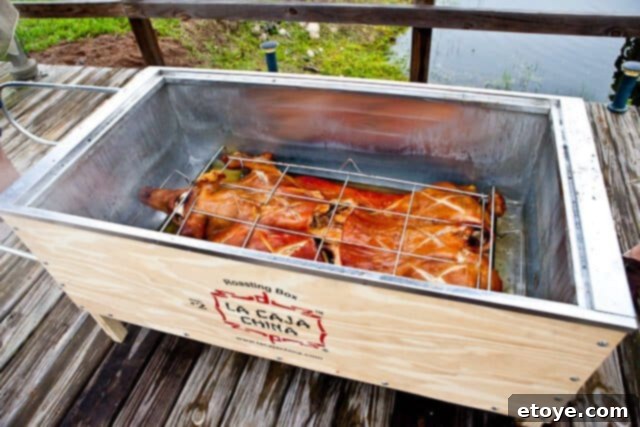Mastering the Art of Whole Pig Roasting: A Comprehensive Guide to La Caja China
Prepare for an extraordinary culinary adventure! This isn’t your typical recipe post with delicate garnishes and quick fixes. We’re diving deep into the primal, rewarding world of whole pig roasting, an experience that promises both spectacle and unforgettable flavors. If the sight of a whole pig before it’s transformed into succulent, crispy-skinned perfection gives you pause, you might want to explore other delightful articles. But for those ready to embrace a true celebration of food and tradition, pull up a chair, grab a cold drink, and let’s embark on this epic journey together!
For the faint of heart, or those who prefer their bacon without acknowledging its origins, this might not be your read. However, if you’re a culinary enthusiast, a passionate home chef, or simply someone who appreciates incredible food and a good story, then you’re in the right place. We’re about to unveil the secrets to achieving a perfect whole pig roast, focusing on the incredibly efficient and renowned La Caja China method. Get ready to impress your guests and savor some of the most delicious pork you’ve ever tasted.
Sourcing Your Whole Pig: Quality Matters for an Exceptional Roast
Every great pig roast begins with a great pig. The quality of your main ingredient is paramount, influencing both flavor and tenderness. In regions like Florida, we are fortunate to have access to dedicated local farmers who prioritize ethical and sustainable practices. For this roast, we partnered with Jim Wood and his family at Palmetto Creek Farm. They specialize in raising free-range, all-natural Hereford pigs, known for their superior meat quality and marbling.

Meeting Jim and his family, including his son Jim, daughter Annesly, and their charming farm dog, truly underscores the farm-to-fork philosophy. Their commitment to raising healthy, happy pigs translates directly into the deliciousness of the final product. While Jim often delivers larger pigs, typically around 250 lbs, we opted for a 100 lb live weight pig for our gathering of approximately 30 people. This meant a dressed weight of about 85 lbs, an ideal size for our chosen roasting vessel, La Caja China, which we’ll discuss in detail shortly.
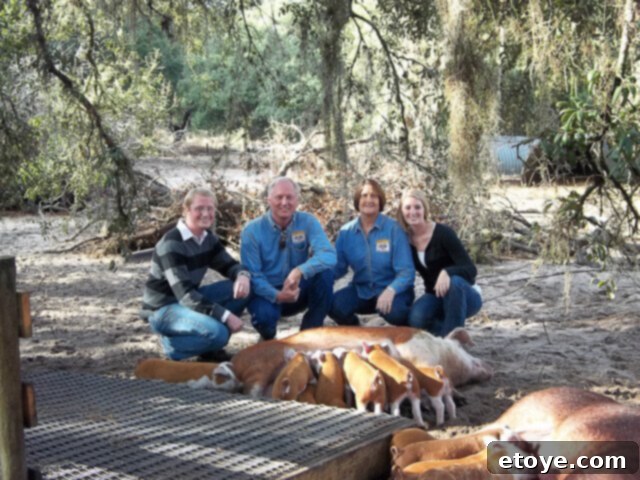
When ordering your whole pig, it’s important to coordinate with your farmer. Palmetto Creek Farm, for example, conducts their slaughtering on Mondays, ensuring fresh delivery on Tuesday. If you’ve never ordered a whole pig before, it’s natural to be surprised by its size! Even a 100 lb pig is substantial, requiring thoughtful planning for transportation and storage.
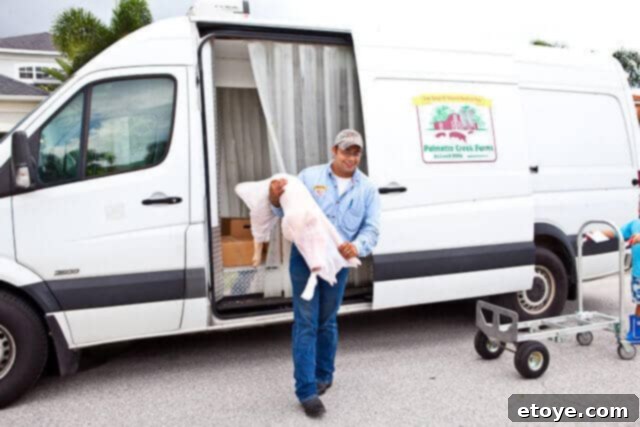
Prepping Your Pig: Storage and Initial Handling
Upon delivery, immediate and proper refrigeration is crucial for food safety. A whole pig, even one around 85 lbs dressed, presents a unique storage challenge. Ideally, you’ll need a dedicated, empty refrigerator or a very large cooler. For our roast, we utilized an empty refrigerator at an old house, as our current home only has one. If you’re planning this at your residence, consider clearing out an unused fridge or investing in a large 150-quart cooler. As you’ll see in later photos, even a cooler of this size provides a snug fit for an 85 lb pig.

Fitting a four-legged, somewhat floppy pig into a standard refrigerator requires some ingenuity. Simply removing the shelves isn’t always enough to accommodate its unique shape.

The solution we found involved carefully wrapping the pig in large, heavy-duty black garbage bags. Securing the bags with packing tape not only keeps the pig contained but also helps prevent any leaks and maintains hygiene within your storage unit. This method also aids in compressing the pig slightly, making it more manageable to position.

Once wrapped, the challenge shifted to keeping the pig securely inside the refrigerator. Its weight and tendency to shift meant the door would often spring open. Our solution was low-tech but effective: stacking heavy boxes against the refrigerator door to keep it firmly shut. This ensured the pig remained at a safe, consistent temperature until the day before the roast.

Unleashing the Power of La Caja China: Your Roasting Partner
Our chosen method for achieving the perfect whole pig roast was La Caja China, affectionately known as “the magic box.” This ingenious roasting device, essentially a wooden box with a charcoal tray on top, is a game-changer for outdoor cooking enthusiasts. We acquired ours from The Outdoor Kitchen in Tampa, FL, a fantastic local resource for all things outdoor culinary.
La Caja China has garnered a significant following and earned accolades from culinary greats like Bobby Flay, Martha Stewart, and Al Roker. Its popularity stems from its unparalleled ability to roast a whole pig in 5 hours or less, consistently delivering incredibly tender meat and that coveted, crispy skin. The concept is elegantly simple: charcoal is placed on the metal lid, and the heat radiates downwards, cooking the pig evenly and efficiently within the enclosed box. This method is so foolproof it has developed its own cult following, especially here in Florida where outdoor roasting is a way of life.
The basic process involves injecting the pig with a flavorful marinade the night before, allowing it to come to room temperature on roasting day, starting with a specific amount of charcoal, adding more charcoal in timed intervals, and finally, flipping the pig to crisp the skin. It’s a method that promises delicious results with surprisingly little fuss.
Crafting the Perfect Marinade: A Taste of the Tropics
A successful pig roast hinges on a deeply flavorful marinade that penetrates the meat, ensuring every bite is moist and delicious. For our roast, we followed Roberto Guerra’s (the owner of La Caja China) classic Mojo Criollo Marinade recipe. This vibrant, zesty marinade is a staple in Cuban and Caribbean cuisine, perfectly complementing the rich flavor of pork.
The Mojo Criollo marinade is a fragrant blend of fresh oranges, lemons, pungent garlic, and a medley of traditional spices. To prepare it, you’ll need to combine all ingredients and let them sit for at least an hour, or preferably overnight, to allow the flavors to fully meld. Before injecting, it’s crucial to strain the marinade thoroughly. This step prevents any pulp or spice particles from clogging your meat injector, ensuring a smooth and efficient marinating process.


From Tub to Table: Cleaning, Seasoning, and Injecting Your Pig
With our flavorful marinade ready, it was time to prepare the star of the show. Before any seasoning or injection, a thorough cleaning of the pig is essential. Since our kitchen sink was, understandably, not large enough for an 85 lb pig, we employed an unconventional but effective solution: the bathtub. My husband, a truly good sport, took on the task of giving the pig a comprehensive scrub.

After a good rinse, we moved on to scrubbing the skin. For this, kosher salt is an excellent tool. Its coarse texture makes it perfect for gently exfoliating the skin, helping to remove any dirt or loose particles and prepare it for maximum crispiness. We used two generous handfuls, ensuring the entire surface was thoroughly scrubbed before another rinse. This technique, also effective on poultry, genuinely makes a difference in the final texture of the skin.
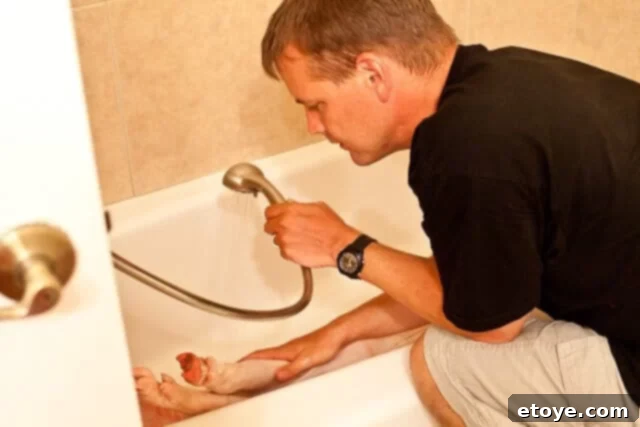
Next, to ensure the pig would lay flat in La Caja China, we needed to further open and flatten its cavity. My husband carefully pressed down on the ribcage, expanding the pig’s form. Now, the moment of truth: injecting the marinade. Using a meat injector with a long needle, we carefully drew up the strained Mojo Criollo.
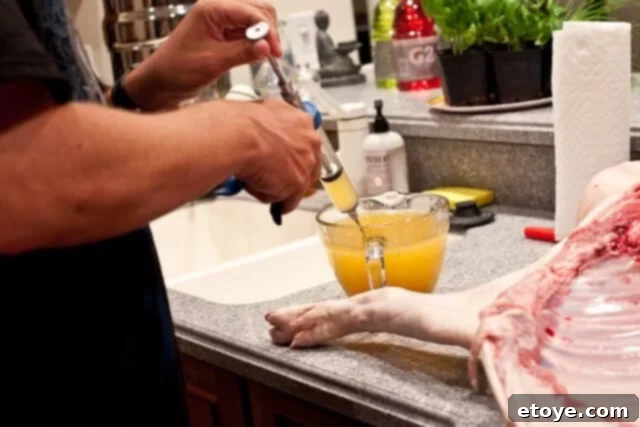
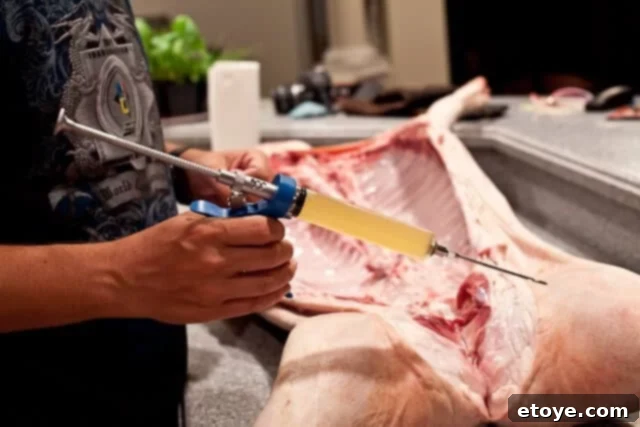
The key to effective injection is to distribute the marinade evenly throughout the meat without piercing the outer skin. This prevents the precious marinade from leaking out. Insert the needle into the fleshy parts, navigating between the skin and the fat/meat layer. You can adjust the angle of the long needle to reach as much muscle as possible, even reaching areas like the cheeks from the neck region. This careful process ensures every part of the pig absorbs the delicious flavors of the Mojo Criollo.

External Seasoning and Overnight Brine
Once injected, we added an extra layer of flavor by scattering fresh orange and lemon slices, along with crushed bay leaves, over the pig. This aromatic foundation was then topped with a generous seasoning of kosher salt and ground cumin. While we opted for this simple yet effective blend, you could certainly use your favorite dry rub for a different flavor profile.
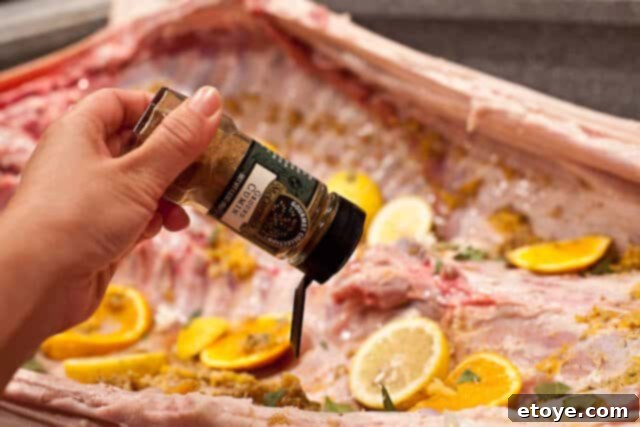
With the seasoning complete, the pig was carefully transferred to the large 150-quart cooler mentioned earlier. To keep it chilled and allow the marinade to work its magic overnight, we surrounded it with bags of ice. It’s crucial to keep the ice in bags rather than directly on the pig. Loose ice would melt and dilute your carefully crafted marinade, washing away all your hard work. The cooler, packed with ice bags, provided the perfect environment for the pig to marinate and chill until the next morning.
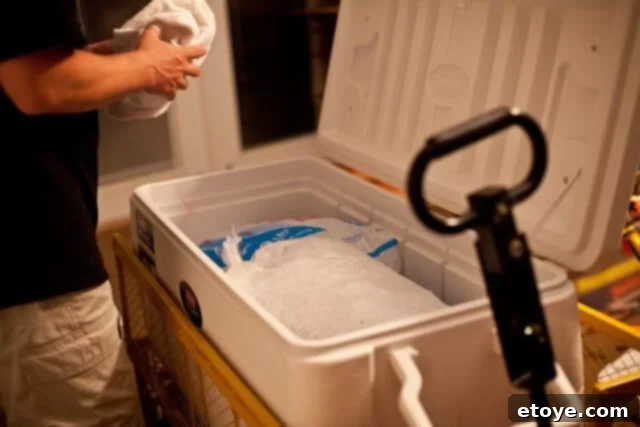
The Grand Roasting Day: Setting Up Your La Caja China
The day of the roast is a symphony of preparation and timing. Precision ensures success. Here’s a crucial breakdown of your timeline:
- **4 hours:** Allow the pig to come to room temperature (around 70°F) before roasting.
- **4 hours (approx):** Actual roasting time in La Caja China.
- **20 minutes:** Resting time for the pig after cooking.
In the morning, we removed the ice from the cooler and left the lid open. After about four hours, the pig reached the ideal internal temperature of 70°F. Now, it was time to prepare the pig for the roaster. Using the provided wire racks and S-hooks from La Caja China, we secured the pig flat. Our friend Charlie joined us to help with the final seasoning. We first discarded the citrus slices and bay leaves, then applied a generous layer of Texas Pig Rub to one side.
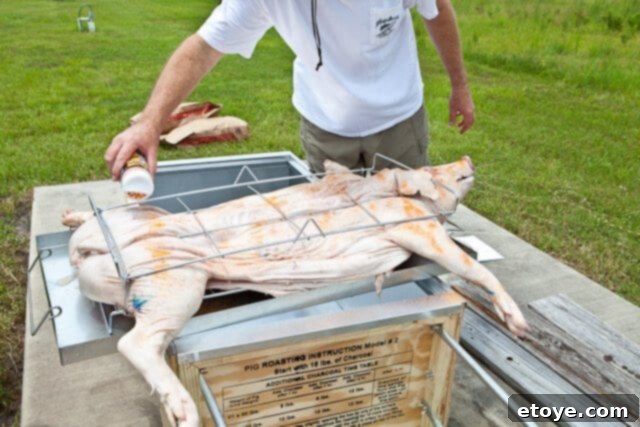
With one side seasoned, we carefully flipped the pig over and repeated the seasoning process on the other side, ensuring a consistent and flavorful crust.
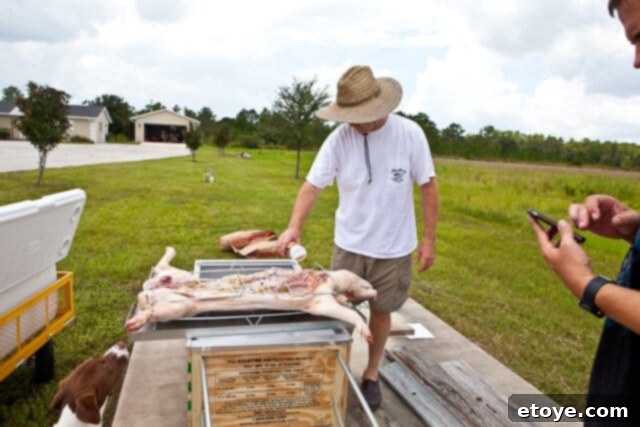
Once fully seasoned, the pig was carefully placed inside La Caja China. It was a snug fit, highlighting the importance of choosing the right-sized pig for your roaster. We inserted a heat-safe meat thermometer into the thickest part of the thigh, ensuring it didn’t touch the bone. A probe thermometer with an alarm is highly recommended for accurate temperature monitoring.
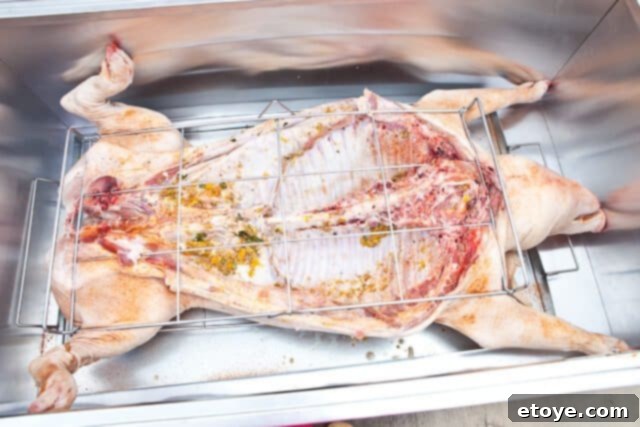
Finally, the metal tray was placed on top, ready to receive the charcoal.
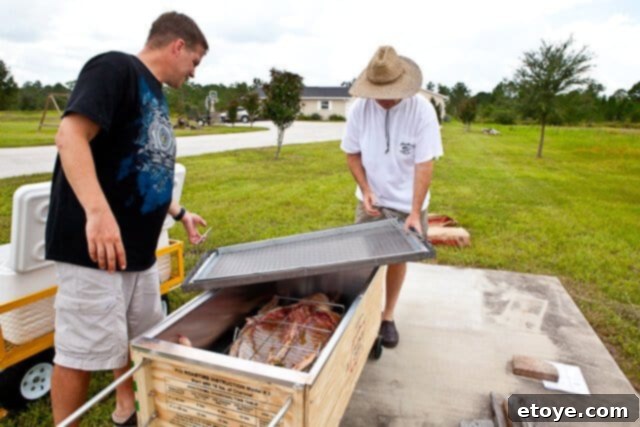
First Flames: Lighting Your Charcoal Safely
When starting your charcoal, always use chimney starters. Avoid charcoal lighter fluid at all costs – it imparts an unpleasant chemical odor and taste to your food. If you absolutely must use self-starting charcoal, use it only for the initial lighting, then switch to regular plain charcoal for subsequent additions.
Roberto Guerra, the owner of La Caja China, provided us with a simplified, fool-proof method for his Box #2, which we used for our 100 lb live weight (85 lb dressed) pig. Begin by lighting 16 pounds of charcoal in your chimney starters. Once the charcoal is glowing hot and covered in ash, carefully dump it onto the metal tray on top of La Caja China.
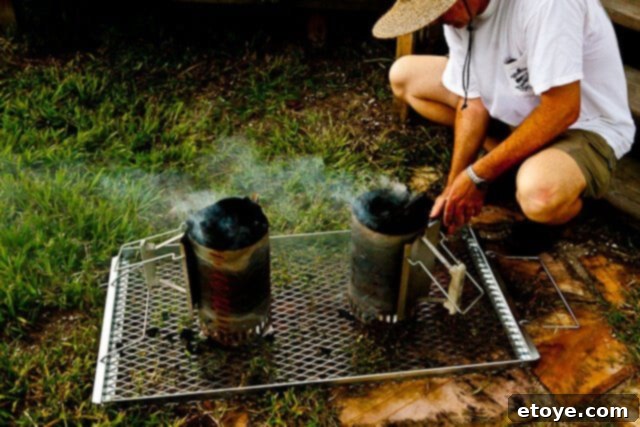
A word of caution and a crucial safety lesson: While our roast was underway, an unexpected rain shower forced us to move the roaster under an umbrella on our dock. This is **highly NOT recommended**. Roasting under an umbrella poses a significant fire hazard, and we were incredibly lucky it didn’t go up in flames. Always have a clear, open, and well-ventilated space for your roaster, ideally a cleared garage with the door open if rain is expected.

Another crucial safety observation came to light when reviewing the photos my friend Charlie took: my husband was wearing open-toed sandals while handling burning hot charcoal on a wet, slippery wooden dock! This is an absolute no-go. When working with hot coals and fire, always wear closed-toe shoes, preferably sturdy boots, and ensure you’re on a stable, non-slip surface. Accidents can happen in an instant, and proper safety gear is non-negotiable.
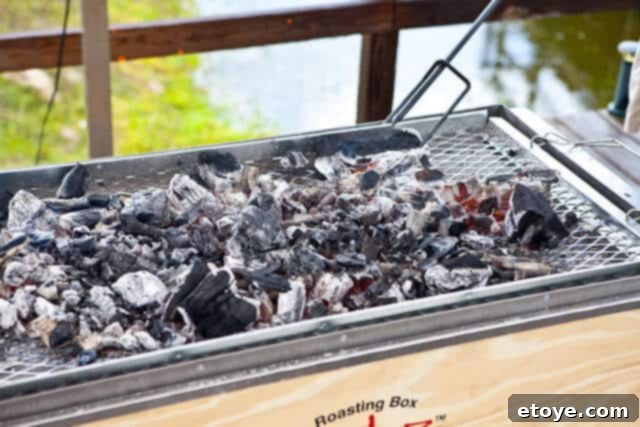
Once the charcoal is carefully spread over the metal tray, your cooking time officially begins. Let the initial 16 pounds burn for one hour.
Mastering the Heat: The La Caja China Roasting Schedule
Consistent heat is key to a perfectly roasted pig. The La Caja China method simplifies this with a precise charcoal addition schedule:
- **START:** Light 16 pounds of charcoal. Once lit and hot, spread it evenly. Cook for 1 hour.
- **1:00 hour mark:** Add an additional 8 pounds of charcoal on top. Cook for another 1 hour.
- **2:00 hour mark:** Add another 8 pounds of charcoal on top. Cook for 30 minutes.
- **2:30 hour mark:** Add the final 4 pounds of charcoal on top. Continue cooking for 30 minutes, or until your meat thermometer reaches an internal temperature of 190°F.
Throughout this process, regularly check your meat thermometer. The 190°F target ensures the pork is thoroughly cooked and incredibly tender. The beauty of La Caja China is its ability to maintain this consistent, high heat, reducing the need for constant monitoring typical of other roasting methods.

The Grand Reveal: Flipping for Flawless Crispy Skin
At the 3-hour mark, it’s time for the big flip – a critical step that ensures that coveted crispy skin. This is definitely a two-person job, so make sure you have a helper ready.
First, carefully lift the metal tray with the hot charcoal off the top of La Caja China. The roaster’s handles are specifically designed to hold this hot tray, allowing you to temporarily set it aside.
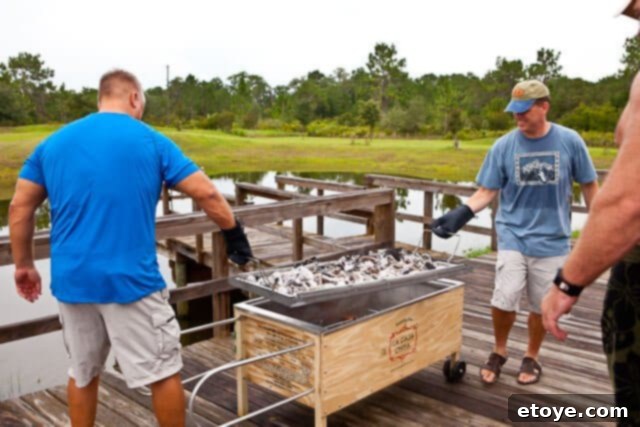
With the tray safely on its designated rests, you can now peek inside and marvel at the beautifully roasted pig beneath. The aroma alone is enough to make your mouth water.
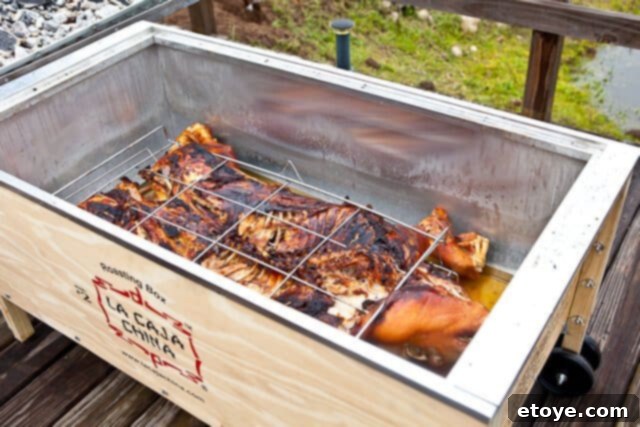
Next, using heat-resistant gloves and the provided wire racks, carefully flip the pig over so the skin side faces up. This allows the direct heat from the charcoal above to crisp up the skin to perfection. Once flipped, score the skin in a grid pattern. This helps the fat render out, creating a crackling texture that is simply irresistible.

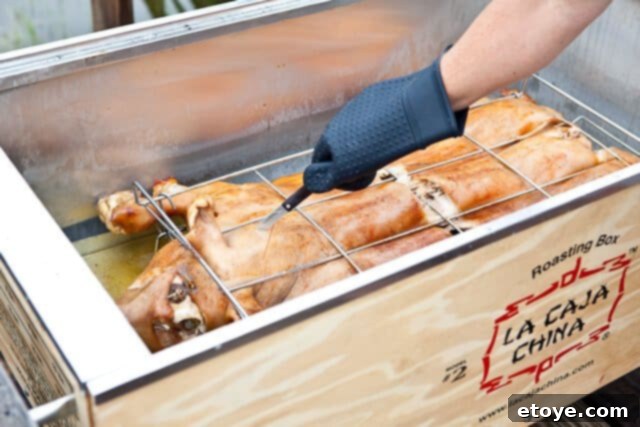
Return the metal tray with the hot charcoal back onto La Caja China. Let the pig cook for another 30 minutes to achieve that beautiful, golden-brown crispy skin. No additional charcoal is needed for this final stage; the residual heat from the existing coals is sufficient.
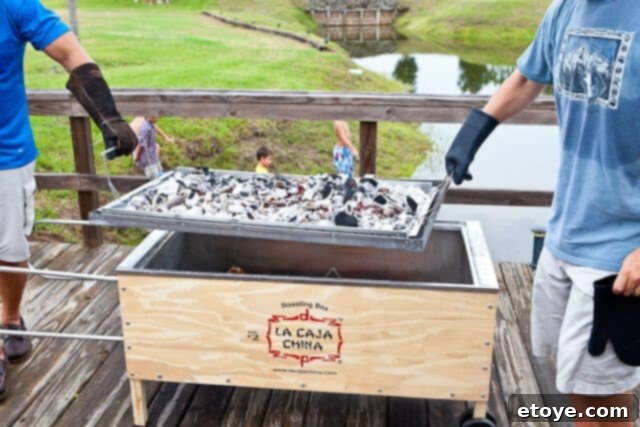
Again, a word on safety: handling scorching hot charcoal requires utmost caution. While tempting to enlist friends for help, ensure everyone involved is wearing appropriate protective gear, including thick heat-resistant gloves and sturdy, closed-toe footwear. Loose sandals and hot coals are a dangerous combination. Prioritize safety above all else.
After 30 minutes, remove the charcoal tray. Your pig should now boast incredibly crispy, crackling skin. If it’s not quite to your liking, you can always put the charcoal back on for another 10 minutes or so to achieve that perfect crispness.
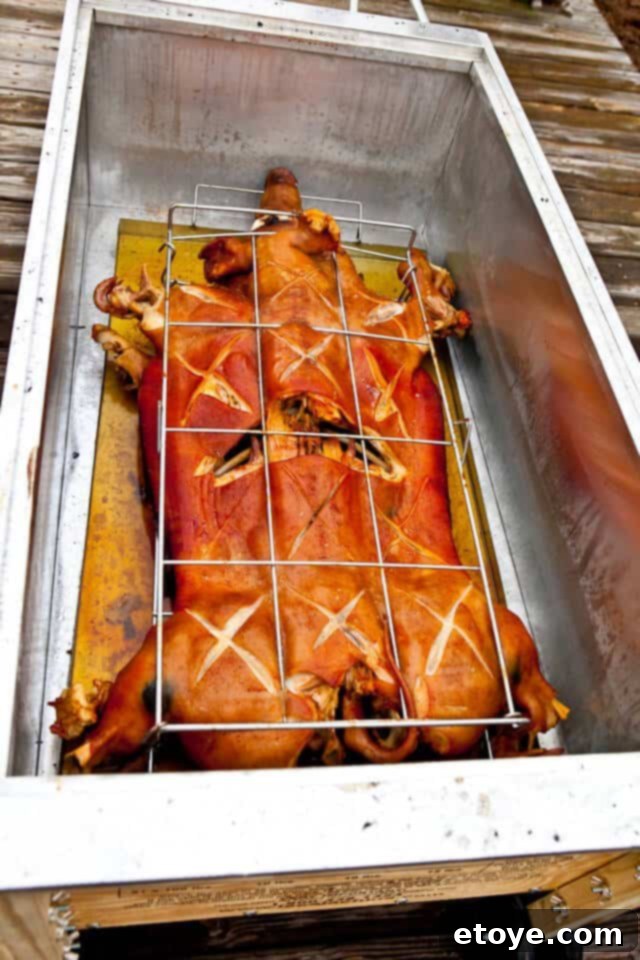
The Ultimate Payoff: Resting, Carving, and Feasting
Once the pig is cooked to perfection and the skin is beautifully crispy, it’s crucial to let it rest for at least 20 minutes before digging in. This resting period allows the juices to redistribute throughout the meat, ensuring every bite is incredibly tender and moist. Skipping this step can result in dry pork, despite all your efforts.
For serving, we set up a large folding table, covered with newspaper, and carefully placed the magnificent roasted pig on top. The sight of the whole roasted pig is a true showstopper and a testament to the hard work and patience that went into its preparation. With gloves on, three people easily pulled the meat apart. The pork was unbelievably juicy and literally fell off the bone, a testament to the La Caja China method and the thorough marination.
The Mojo Criollo marinade truly shone through, infusing the pork with delightful hints of citrus that perfectly cut through the richness of the meat. To complete the experience, we set out flour tortillas, an array of salsas, and fresh lime wedges, inviting guests to create their own delicious pork tacos. This interactive serving style adds to the festive atmosphere and allows everyone to customize their meal.
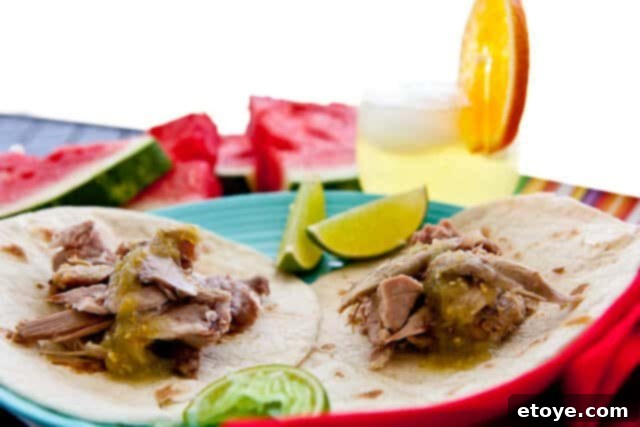
A whole pig roast is more than just a meal; it’s an event, a celebration of community, and a culinary triumph. The flavors, the aromas, and the shared experience create lasting memories. Whether you’re hosting a large gathering or simply eager to master an impressive outdoor cooking technique, the La Caja China method for roasting a whole pig is an endeavor that promises immense satisfaction and absolutely delicious results. So, go ahead, take a bite, and savor the incredible flavor of your very own perfectly roasted pig!

